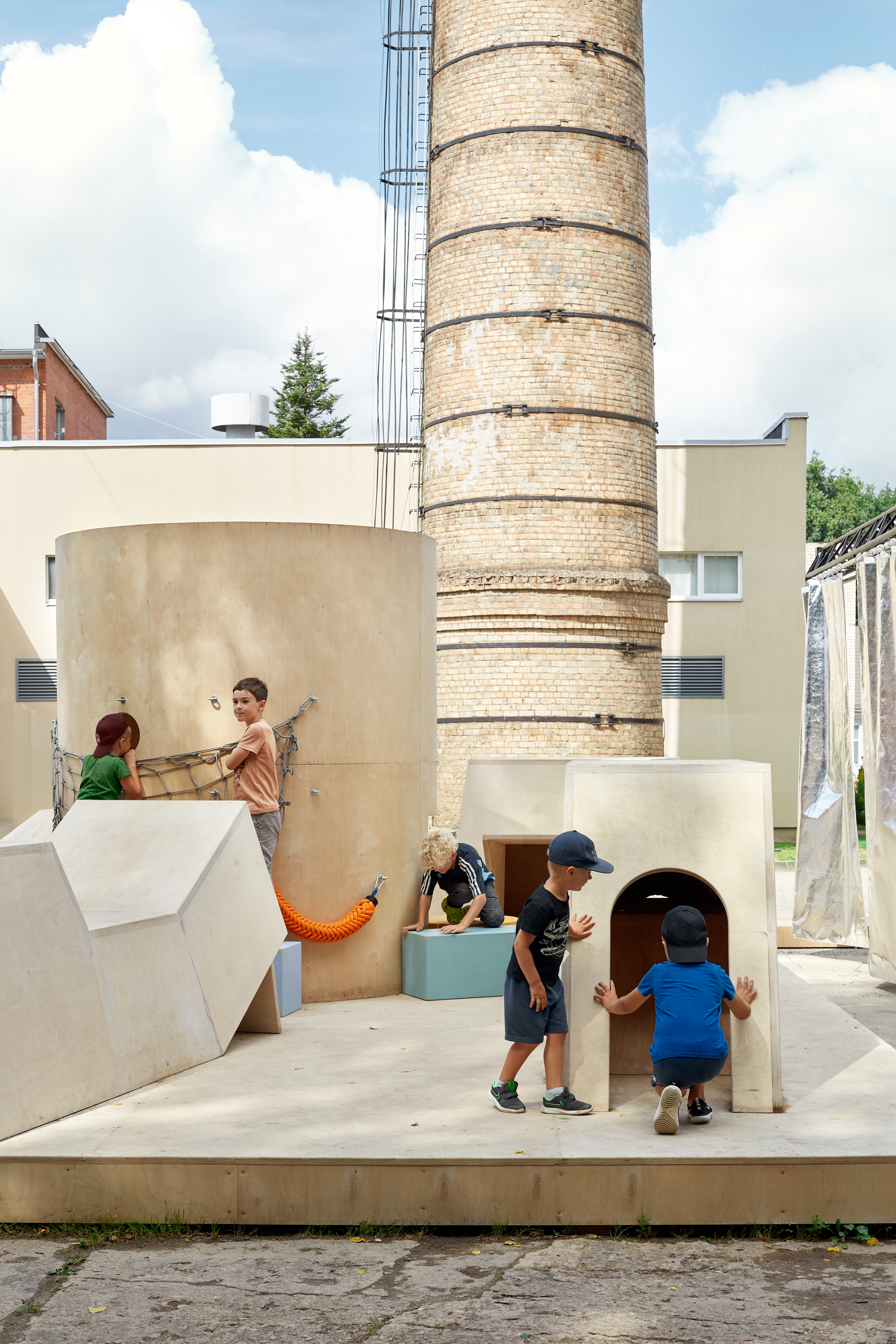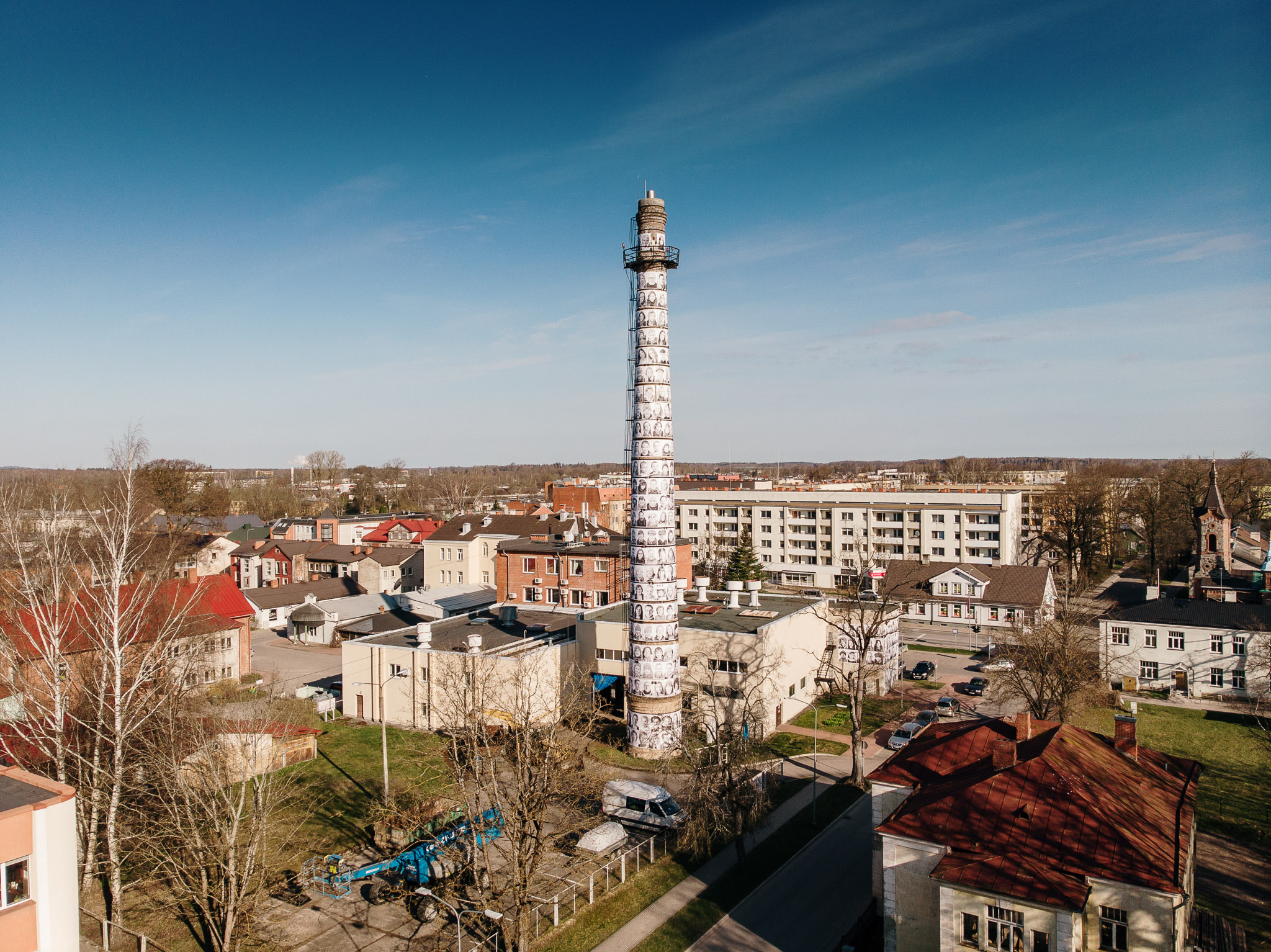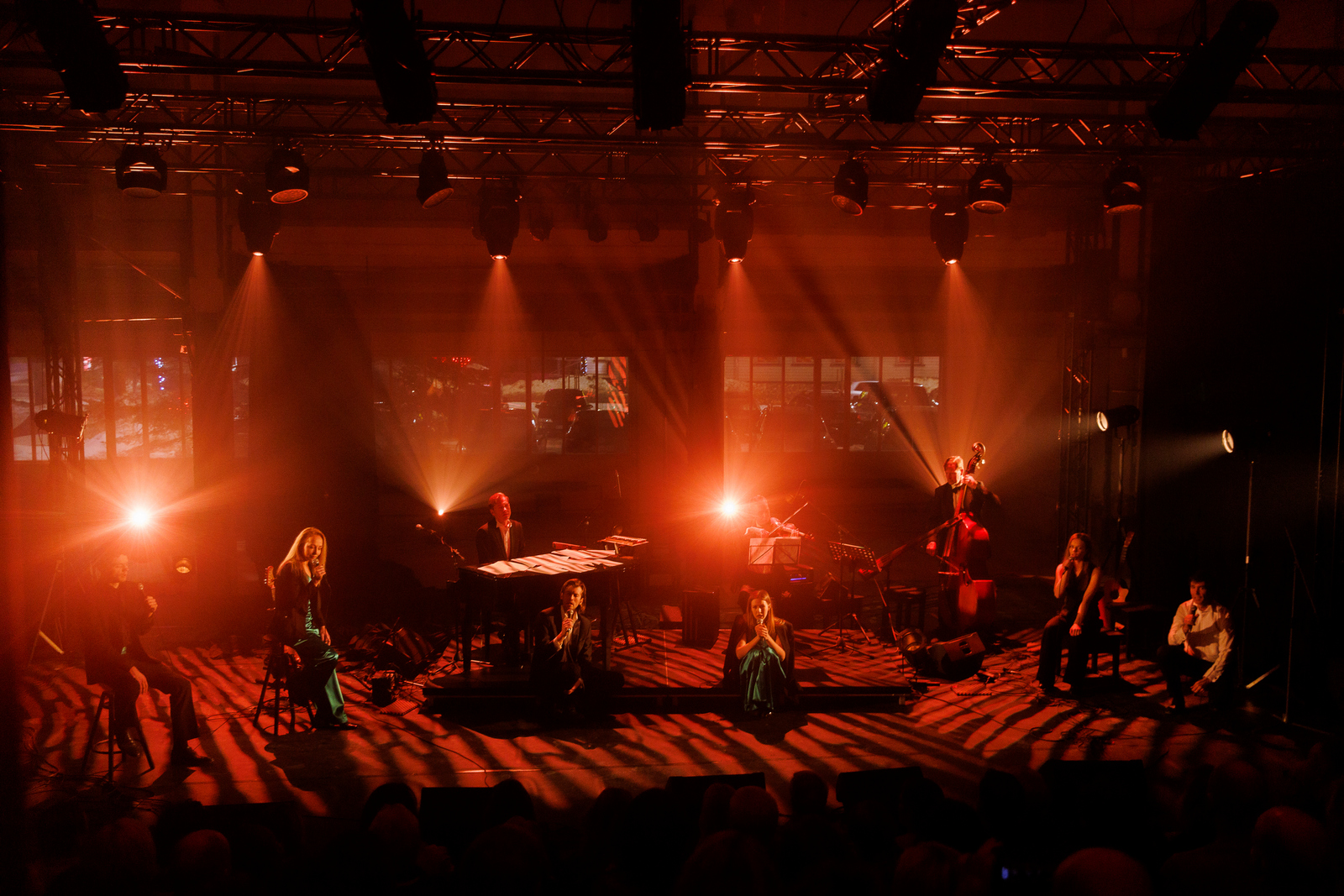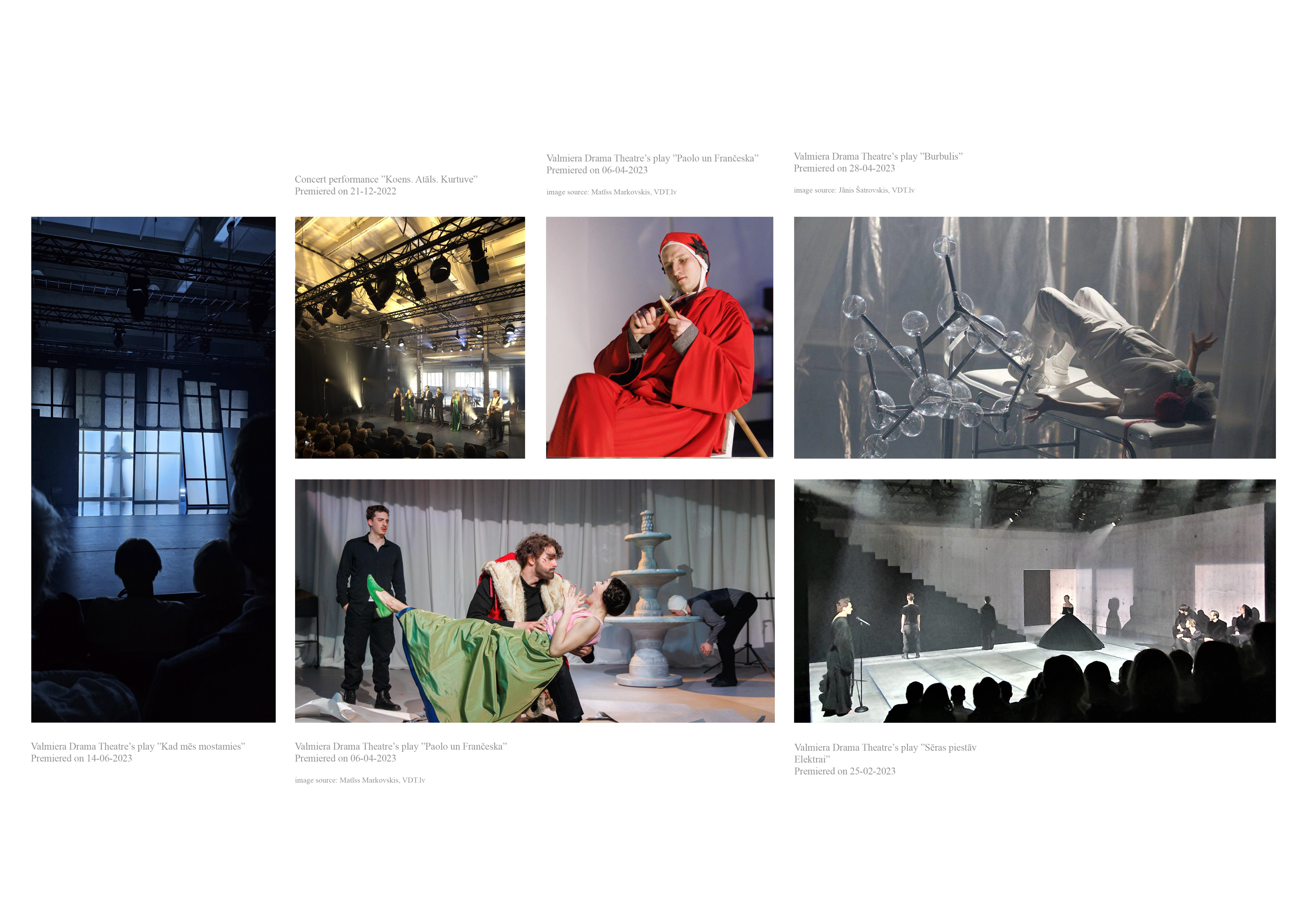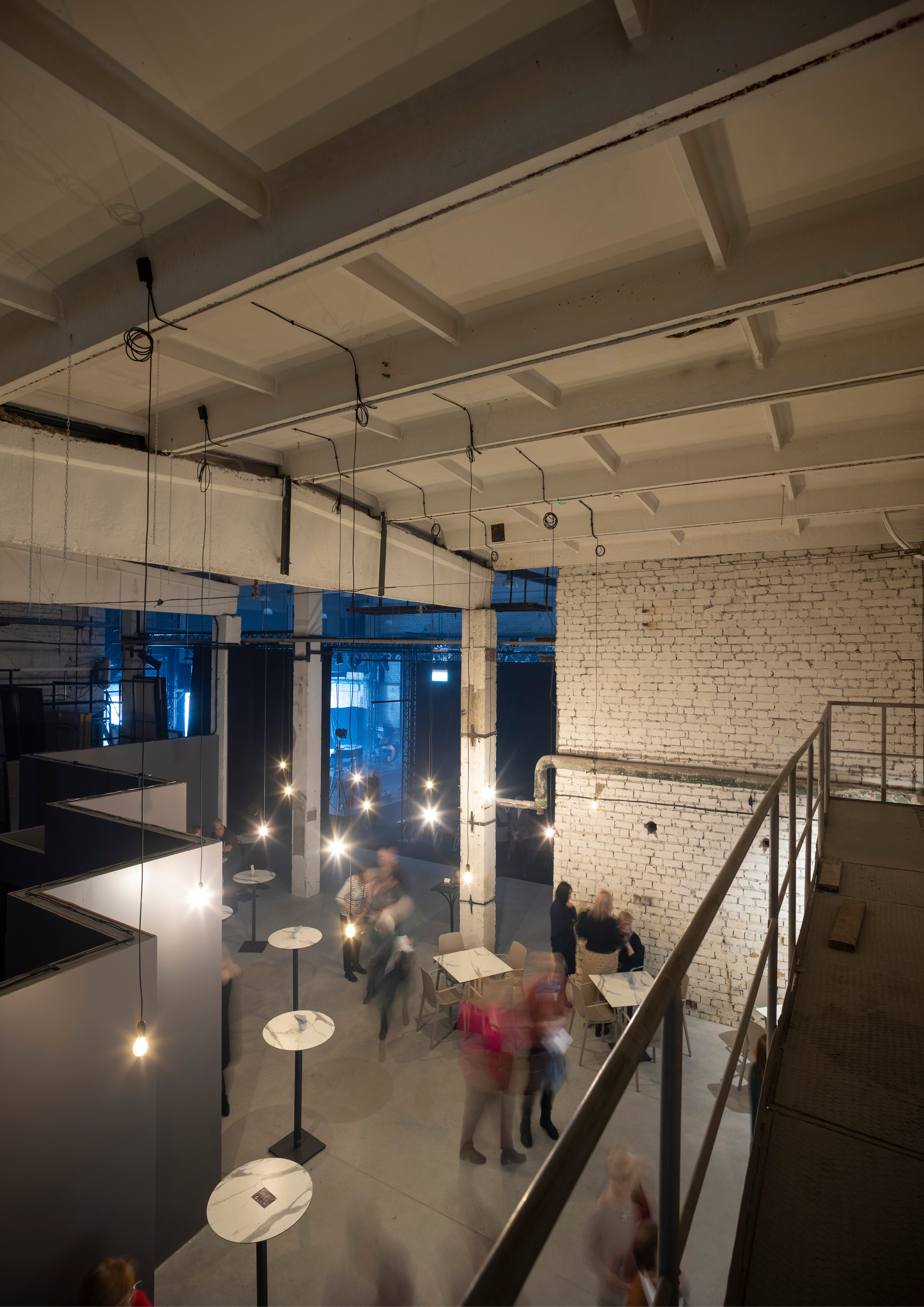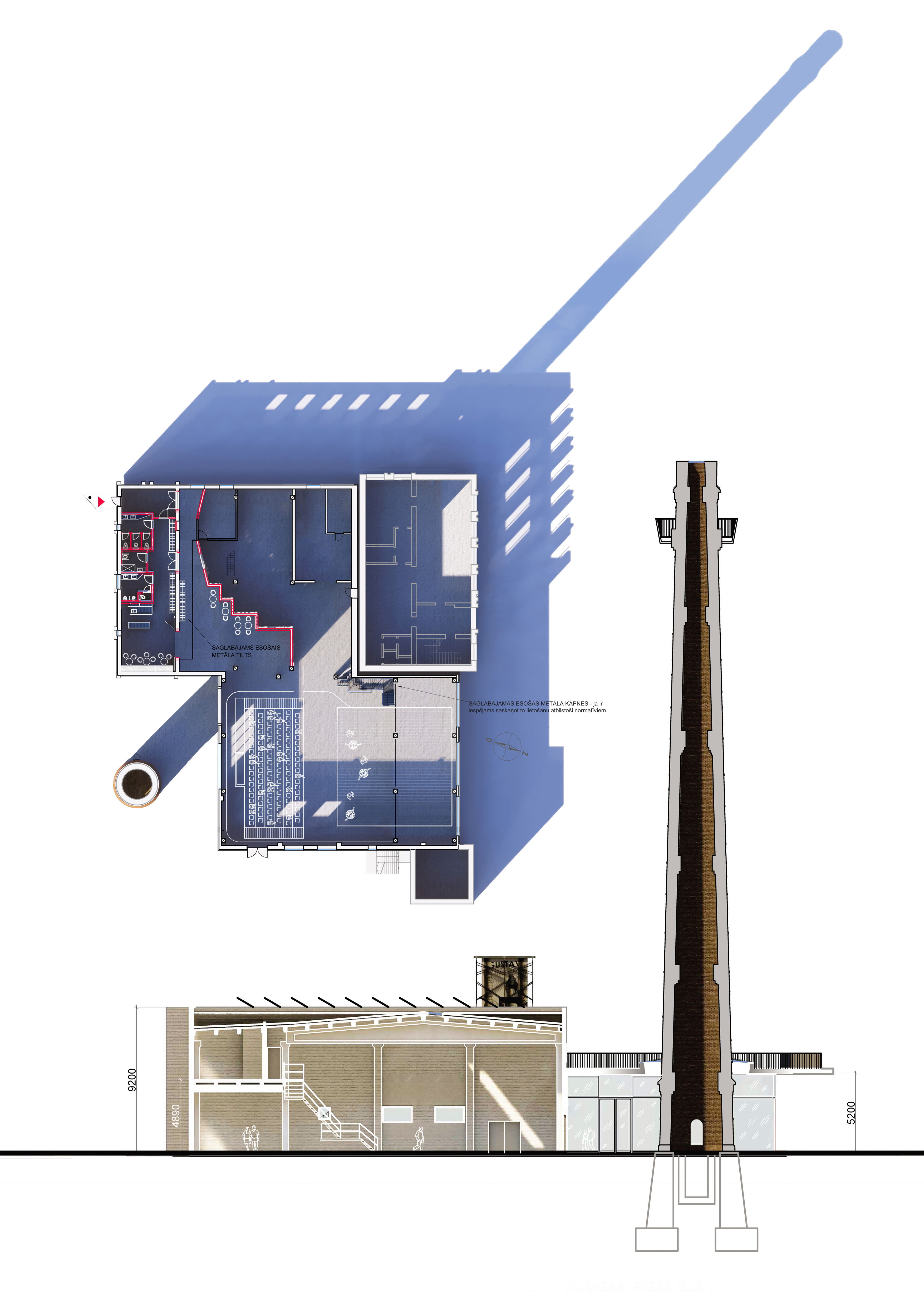Regaining a sense of belonging
Kurtuve: From Industry to Creativity
Kurtuve in Valmiera, Latvia: A Former Boiler House Transformed into a Contemporary Art Space
A former boiler house in Valmiera—an industrial city in far northern Latvia—Kurtuve was acquired by the municipality with the vision of creating a dynamic art space. Through a collaborative effort involving architects, artists, and local residents, the venue has been transformed while preserving its raw industrial aesthetic and integrating modern, flexible features. Kurtuve now fosters resilience, and cultural access beyond Riga, redefining the region’s cultural landscape.
Latvia
Regional
Valmiera County
It addresses urban-rural linkages
It refers to a physical transformation of the built environment (hard investment)
Yes
2023-11-12
No
No
No
As a representative of an organisation, in partnership with other organisations
Kurtuve is a cultural venue transformed from Valmiera’s 1970s boiler house into a multidisciplinary space for contemporary arts, exhibitions, and public events. Located in far northern Latvia, Valmiera is an industrial city where much of its architectural heritage was lost due to severe bombing and fires during several wars. Thus, the adaptive reuse of industrial structures like Kurtuve plays a crucial role in preserving identity and fostering cultural regeneration.
Initially a temporary home for the Valmiera Drama Theatre, the venue has since evolved into a permanent centre for artistic exploration, expanding Latvia’s cultural landscape beyond the capital. Recognising the need for a contemporary art space, the municipality acquired the privately owned boiler house, envisioning it as a cultural hub. Through collaboration between architects, artists, and local residents, Kurtuve was reimagined as a space that balances industrial heritage with modern creative needs.
Envisioned during Valmiera’s European Capital of Culture 2027 bid, Kurtuve was conceived as a lasting cultural anchor. Although the city did not secure the title, its commitment to adaptive reuse and artistic growth remained strong. Today, Kurtuve is a symbol of resilience, inclusivity, and architectural ingenuity, demonstrating how modest industrial buildings can be transformed into inspiring cultural spaces through planning and thoughtful design.
Led by Sudraba Arhitektūra, the design preserves the industrial character and 50-metre chimney while integrating modern, flexible features that enhance usability. This sensitive architectural approach respects the raw aesthetic of the structure while ensuring adaptability for artistic functions.
Today, Kurtuve is a venue for art installations, performances, music, workshops, and educational programmes. It seeks to expand as a centre for contemporary arts, championing local talent, and driving urban revitalisation.
Initially a temporary home for the Valmiera Drama Theatre, the venue has since evolved into a permanent centre for artistic exploration, expanding Latvia’s cultural landscape beyond the capital. Recognising the need for a contemporary art space, the municipality acquired the privately owned boiler house, envisioning it as a cultural hub. Through collaboration between architects, artists, and local residents, Kurtuve was reimagined as a space that balances industrial heritage with modern creative needs.
Envisioned during Valmiera’s European Capital of Culture 2027 bid, Kurtuve was conceived as a lasting cultural anchor. Although the city did not secure the title, its commitment to adaptive reuse and artistic growth remained strong. Today, Kurtuve is a symbol of resilience, inclusivity, and architectural ingenuity, demonstrating how modest industrial buildings can be transformed into inspiring cultural spaces through planning and thoughtful design.
Led by Sudraba Arhitektūra, the design preserves the industrial character and 50-metre chimney while integrating modern, flexible features that enhance usability. This sensitive architectural approach respects the raw aesthetic of the structure while ensuring adaptability for artistic functions.
Today, Kurtuve is a venue for art installations, performances, music, workshops, and educational programmes. It seeks to expand as a centre for contemporary arts, championing local talent, and driving urban revitalisation.
Adaptive reuse
Public engagement
Contemporary art accessibility
Cultural resilience
Industrial heritage
Kurtuve exemplifies sustainable cultural regeneration, showing how an underused industrial site can become a thriving cultural hub. Every stage of the project embraced environmental responsibility, with resource efficiency and minimal interventions guiding the transformation.
Substantial portions of the original brickwork, steel framework, and concrete were retained, drastically reducing the carbon footprint compared to a new construction. By respecting the existing materials and structure, Kurtuve demonstrates how smaller-scale industrial relics can acquire new purpose—and new beauty—when entrusted to thoughtful architectural planning.
Beyond its physical transformation, Kurtuve contributes to long-term urban sustainability by strengthening Valmiera’s identity as a creative, resilient city. This is achieved by offering an inclusive cultural model that prioritises heritage preservation, community engagement, and ecological mindfulness, demonstrating a holistic view of sustainability that spans environmental and cultural dimensions.
Substantial portions of the original brickwork, steel framework, and concrete were retained, drastically reducing the carbon footprint compared to a new construction. By respecting the existing materials and structure, Kurtuve demonstrates how smaller-scale industrial relics can acquire new purpose—and new beauty—when entrusted to thoughtful architectural planning.
Beyond its physical transformation, Kurtuve contributes to long-term urban sustainability by strengthening Valmiera’s identity as a creative, resilient city. This is achieved by offering an inclusive cultural model that prioritises heritage preservation, community engagement, and ecological mindfulness, demonstrating a holistic view of sustainability that spans environmental and cultural dimensions.
Kurtuve is an example of how architecture can reveal the beauty in unassuming, functional buildings. Valmiera, an industrial city shaped by decades of manufacturing and production, has a cultural identity rooted in its industrial past. Throughout history, Valmiera has been devastated by numerous wars, each leaving the city in ruins and erasing much of its architectural heritage. Against this backdrop, Kurtuve builds on the city’s existing narrative, transforming an industrial site into a cultural venue that remains familiar and recognisable to its residents.
Its redesigned interior preserves the raw essence of the original boiler house—exposed brick, rugged steel columns, and original concrete walls—while integrating modern infrastructure essential for artistic expression and events. This balance between past and present ensures Kurtuve remains authentic and inviting, strengthening the connection between Valmiera’s industrial heritage and its evolving cultural landscape.
A key aspect of Kurtuve’s transformation is the active involvement of local communities in shaping both its physical development and creative programming. Residents, artists, and cultural organisations contributed ideas, ensuring the venue reflects the needs and aspirations of the people it serves. This co-creative approach has made Kurtuve more than just an art space—it has become a shared cultural home, shaped by and for the community.
By embracing the site’s industrial aesthetic and integrating participatory design, Kurtuve fosters emotional resonance, allowing visitors to experience a dialogue between heritage and innovation. Through festivals, exhibitions, and interdisciplinary collaborations, it demonstrates that even a modest industrial structure can become a vibrant cultural stage. By placing contemporary artistic expression within Valmiera’s industrial identity and shaped by local input, Kurtuve enriches the aesthetic landscape and creates a space that is both familiar and transformative
Its redesigned interior preserves the raw essence of the original boiler house—exposed brick, rugged steel columns, and original concrete walls—while integrating modern infrastructure essential for artistic expression and events. This balance between past and present ensures Kurtuve remains authentic and inviting, strengthening the connection between Valmiera’s industrial heritage and its evolving cultural landscape.
A key aspect of Kurtuve’s transformation is the active involvement of local communities in shaping both its physical development and creative programming. Residents, artists, and cultural organisations contributed ideas, ensuring the venue reflects the needs and aspirations of the people it serves. This co-creative approach has made Kurtuve more than just an art space—it has become a shared cultural home, shaped by and for the community.
By embracing the site’s industrial aesthetic and integrating participatory design, Kurtuve fosters emotional resonance, allowing visitors to experience a dialogue between heritage and innovation. Through festivals, exhibitions, and interdisciplinary collaborations, it demonstrates that even a modest industrial structure can become a vibrant cultural stage. By placing contemporary artistic expression within Valmiera’s industrial identity and shaped by local input, Kurtuve enriches the aesthetic landscape and creates a space that is both familiar and transformative
Kurtuve is designed to welcome everyone, removing barriers—physical, financial, and social—to participation in contemporary art. By focusing on affordability and accessibility, the venue ensures that cutting-edge cultural experiences are not confined to Latvia’s capital city.
This inclusive spirit is evident in the diversity of its programming. Kurtuve supports emerging artists, established practitioners, and local creatives from a variety of backgrounds, promoting cross-generational and cross-cultural dialogue. Free exhibitions, workshops, and community events further extend its openness, offering people of all ages and abilities a chance to engage in artistic discovery.
Kurtuve’s governance model is rooted in community collaboration. Local residents and policymakers contribute to programme decisions, shaping the venue’s evolution and embedding inclusivity into its very foundation. Through this co-creative process, Kurtuve demonstrates how accessible cultural spaces can flourish when municipalities value strategic resource use and the architectural renewal of existing buildings.
This inclusive spirit is evident in the diversity of its programming. Kurtuve supports emerging artists, established practitioners, and local creatives from a variety of backgrounds, promoting cross-generational and cross-cultural dialogue. Free exhibitions, workshops, and community events further extend its openness, offering people of all ages and abilities a chance to engage in artistic discovery.
Kurtuve’s governance model is rooted in community collaboration. Local residents and policymakers contribute to programme decisions, shaping the venue’s evolution and embedding inclusivity into its very foundation. Through this co-creative process, Kurtuve demonstrates how accessible cultural spaces can flourish when municipalities value strategic resource use and the architectural renewal of existing buildings.
Local residents, artists, and cultural organisations have actively shaped Kurtuve from the outset. Through community forums, participatory workshops, and co-created events, the venue maintains its people-centred ethos.
An especially notable example was the Speak Out event in April 2023, facilitated by the Latvian Academy of Culture alongside Valmiera’s Cultural Department under the EU Horizon project IN SITU. Attendees explored potential uses for Kurtuve and envisioned a community-centred, multifunctional cultural site. These ideas, ranging from artist residencies to an urban garden, guided Kurtuve’s growth and deepened its civic foundation.
Additionally, Valmiera’s broader participatory culture—bolstered by initiatives from the Valmiera County Foundation—has ensured that citizens regularly influence development strategies. Kurtuve is thus a vivid outcome of bottom-up cultural policymaking, shaped by the community it serves and remaining flexible enough to adapt as local needs evolve.
An especially notable example was the Speak Out event in April 2023, facilitated by the Latvian Academy of Culture alongside Valmiera’s Cultural Department under the EU Horizon project IN SITU. Attendees explored potential uses for Kurtuve and envisioned a community-centred, multifunctional cultural site. These ideas, ranging from artist residencies to an urban garden, guided Kurtuve’s growth and deepened its civic foundation.
Additionally, Valmiera’s broader participatory culture—bolstered by initiatives from the Valmiera County Foundation—has ensured that citizens regularly influence development strategies. Kurtuve is thus a vivid outcome of bottom-up cultural policymaking, shaped by the community it serves and remaining flexible enough to adapt as local needs evolve.
Kurtuve exemplifies collaboration across multiple levels—local, regional, national, and European—bringing together diverse stakeholders to shape its cultural and architectural vision.
• Local: Valmiera Municipality provides administrative and financial support, while the Cultural Department and Valmiera County Foundation lead grassroots engagement efforts, ensuring that the space remains community-driven and accessible.
• Regional: Cultural organisations, educational institutions, and NGOs collaborate on arts programmes, fostering interdisciplinary projects that enhance the region’s cultural vibrancy.
• National: Latvia’s Ministry of Culture supports the reuse of industrial heritage, and Kurtuve has received recognition through its nomination for the Latvian Architecture Award, underlining its architectural and cultural significance.
• European: By aligning with cross-border networks such as IN SITU and hosting the International School of Architects FestivaL’and, co-organised by the Art Academy of Latvia, Kurtuve highlights how a smaller city can innovate in cultural regeneration. These collaborations contribute to broader discussions on sustainable urban development, experimental architecture, and creative exchange across Europe.
In addition to its primary cultural stakeholders, children and artistic communities are also key secondary stakeholders. The summer playground near Kurtuve, designed as an extension of its creative public space, has been nominated for the Latvian Design Award, the highest recognition in Latvia, overseen by the Ministry of Culture. This initiative reflects Kurtuve’s broader mission of fostering inclusivity, engaging different age groups, and strengthening cultural participation beyond traditional artistic spaces.
This multi-tiered engagement ensures that Kurtuve’s local impact extends far beyond Valmiera, strengthening its position in national and EU-wide dialogues on architecture, inclusivity, and cultural revitalisation.
• Local: Valmiera Municipality provides administrative and financial support, while the Cultural Department and Valmiera County Foundation lead grassroots engagement efforts, ensuring that the space remains community-driven and accessible.
• Regional: Cultural organisations, educational institutions, and NGOs collaborate on arts programmes, fostering interdisciplinary projects that enhance the region’s cultural vibrancy.
• National: Latvia’s Ministry of Culture supports the reuse of industrial heritage, and Kurtuve has received recognition through its nomination for the Latvian Architecture Award, underlining its architectural and cultural significance.
• European: By aligning with cross-border networks such as IN SITU and hosting the International School of Architects FestivaL’and, co-organised by the Art Academy of Latvia, Kurtuve highlights how a smaller city can innovate in cultural regeneration. These collaborations contribute to broader discussions on sustainable urban development, experimental architecture, and creative exchange across Europe.
In addition to its primary cultural stakeholders, children and artistic communities are also key secondary stakeholders. The summer playground near Kurtuve, designed as an extension of its creative public space, has been nominated for the Latvian Design Award, the highest recognition in Latvia, overseen by the Ministry of Culture. This initiative reflects Kurtuve’s broader mission of fostering inclusivity, engaging different age groups, and strengthening cultural participation beyond traditional artistic spaces.
This multi-tiered engagement ensures that Kurtuve’s local impact extends far beyond Valmiera, strengthening its position in national and EU-wide dialogues on architecture, inclusivity, and cultural revitalisation.
Kurtuve’s success is rooted in a transdisciplinary approach that unites architects, cultural managers, artists, educators, and policy experts, fostering innovation at the intersection of architecture, culture, and community development.
• Architecture: Led by Sudraba Arhitektūra, the adaptive reuse design preserves the building’s industrial heritage while enabling contemporary cultural functions. The transformation respects the original materials, retaining the raw aesthetic of the boiler house while integrating flexible infrastructure to support artistic expression.
• Research & Policy: Partnerships with the Latvian Academy of Culture embed Kurtuve in broader debates on cultural sustainability, adaptive reuse, and the role of contemporary design in revitalising industrial heritage, particularly in non-metropolitan areas. As host of the International School of Architects FestivaL’and, co-organised by the Art Academy of Latvia, Kurtuve serves as a hub for experimental architecture and sustainable urbanism, providing a platform for architects, designers, and urbanists to explore innovative approaches to place-making. Additionally, through collaboration with European networks such as IN SITU, Kurtuve contributes to policy discussions on cultural infrastructure, creative economies, and the decentralisation of culture beyond major urban centres.
• Art & Culture: A blend of performances, exhibitions, and workshops ensures interdisciplinary cross-pollination, engaging local and international creative professionals. Artistic communities play a key role in shaping the space’s identity, reinforcing Kurtuve’s position as a dynamic meeting point for contemporary cultural exchange and experimentation.
This synergy across disciplines makes Kurtuve more than just an architectural project—it is a cultural hub, demonstrating how thoughtful design and collaboration can transform even modest industrial structures into vibrant centres for artistic and community engagement.
• Architecture: Led by Sudraba Arhitektūra, the adaptive reuse design preserves the building’s industrial heritage while enabling contemporary cultural functions. The transformation respects the original materials, retaining the raw aesthetic of the boiler house while integrating flexible infrastructure to support artistic expression.
• Research & Policy: Partnerships with the Latvian Academy of Culture embed Kurtuve in broader debates on cultural sustainability, adaptive reuse, and the role of contemporary design in revitalising industrial heritage, particularly in non-metropolitan areas. As host of the International School of Architects FestivaL’and, co-organised by the Art Academy of Latvia, Kurtuve serves as a hub for experimental architecture and sustainable urbanism, providing a platform for architects, designers, and urbanists to explore innovative approaches to place-making. Additionally, through collaboration with European networks such as IN SITU, Kurtuve contributes to policy discussions on cultural infrastructure, creative economies, and the decentralisation of culture beyond major urban centres.
• Art & Culture: A blend of performances, exhibitions, and workshops ensures interdisciplinary cross-pollination, engaging local and international creative professionals. Artistic communities play a key role in shaping the space’s identity, reinforcing Kurtuve’s position as a dynamic meeting point for contemporary cultural exchange and experimentation.
This synergy across disciplines makes Kurtuve more than just an architectural project—it is a cultural hub, demonstrating how thoughtful design and collaboration can transform even modest industrial structures into vibrant centres for artistic and community engagement.
Kurtuve stands apart from conventional cultural institutions, demonstrating how a disused industrial site can be transformed into a thriving arts venue when local authorities, architects, and creative professionals commit to thoughtful reinvention. In a city shaped by industry, Kurtuve not only preserves the historical narrative but also reimagines it, proving that even modest, utilitarian buildings can become cultural landmarks when approached with vision and care.
Its fluid programming merges contemporary art exhibitions, educational activities, and community initiatives under one adaptable roof. By embedding co-creation into its ethos—welcoming ideas from citizens, artists, and community groups—Kurtuve sets a precedent for democratic cultural production. This inclusive approach ensures that the space remains dynamic, continuously evolving to reflect the needs and aspirations of the community it serves.
Moreover, the project’s sustainable transformation, rooted in adaptive reuse, demonstrates how existing structures can be upgraded rather than replaced. By prioritising material conservation and minimal intervention, Kurtuve not only respects industrial heritage but also aligns with circular economy principles—reducing waste, lowering environmental impact, and maximising the cultural potential of pre-existing infrastructure. As a result, Kurtuve serves as a scalable prototype for small-to-mid-sized European cities seeking to revitalise underused spaces through culturally led regeneration, positioning industrial heritage as a resource for creative growth and social inclusion.
Its fluid programming merges contemporary art exhibitions, educational activities, and community initiatives under one adaptable roof. By embedding co-creation into its ethos—welcoming ideas from citizens, artists, and community groups—Kurtuve sets a precedent for democratic cultural production. This inclusive approach ensures that the space remains dynamic, continuously evolving to reflect the needs and aspirations of the community it serves.
Moreover, the project’s sustainable transformation, rooted in adaptive reuse, demonstrates how existing structures can be upgraded rather than replaced. By prioritising material conservation and minimal intervention, Kurtuve not only respects industrial heritage but also aligns with circular economy principles—reducing waste, lowering environmental impact, and maximising the cultural potential of pre-existing infrastructure. As a result, Kurtuve serves as a scalable prototype for small-to-mid-sized European cities seeking to revitalise underused spaces through culturally led regeneration, positioning industrial heritage as a resource for creative growth and social inclusion.
Kurtuve’s development follows a holistic strategy grounded in three core pillars—adaptive reuse, participatory design, and interdisciplinary collaboration—ensuring it remains deeply connected to Valmiera’s urban and cultural fabric.
1. Adaptive Reuse and Minimal Intervention
The transformation prioritised preserving the building’s industrial integrity—brick, concrete, and steel—while introducing cost-effective, functional modifications. This balanced approach safeguards heritage while allowing flexibility for artistic and community-driven use.
2. Participatory Design and Co-Creation
Through initiatives like the Speak Out forum, Kurtuve became a co-created space, shaped by input from residents, artists, and policymakers. This participatory process ensures that its development and programming reflect the evolving needs of the local community.
3. Interdisciplinary and Collaborative Model
Architects, cultural managers, urban planners, and academic institutions worked together to align Kurtuve with Valmiera’s broader development strategies. Engagement with European networks such as IN SITU reinforced its role as a case study for sustainable cultural innovation in mid-sized cities.
By integrating these three pillars, Kurtuve serves as a dynamic, forward-looking cultural hub, bridging heritage preservation, community participation, and creative exploration.
1. Adaptive Reuse and Minimal Intervention
The transformation prioritised preserving the building’s industrial integrity—brick, concrete, and steel—while introducing cost-effective, functional modifications. This balanced approach safeguards heritage while allowing flexibility for artistic and community-driven use.
2. Participatory Design and Co-Creation
Through initiatives like the Speak Out forum, Kurtuve became a co-created space, shaped by input from residents, artists, and policymakers. This participatory process ensures that its development and programming reflect the evolving needs of the local community.
3. Interdisciplinary and Collaborative Model
Architects, cultural managers, urban planners, and academic institutions worked together to align Kurtuve with Valmiera’s broader development strategies. Engagement with European networks such as IN SITU reinforced its role as a case study for sustainable cultural innovation in mid-sized cities.
By integrating these three pillars, Kurtuve serves as a dynamic, forward-looking cultural hub, bridging heritage preservation, community participation, and creative exploration.
Kurtuve serves as a replicable model for any locality seeking to transform unused industrial structures into vibrant cultural venues. Its success demonstrates how even modest buildings can be revitalised through strategic planning, adaptive reuse, and community engagement.
Key transferable aspects include:
• Adaptive Reuse: Retaining structural authenticity and local identity while integrating modern features that enhance usability.
• Community-Led Programming: Encouraging residents and stakeholders to co-create programmes, ensuring genuine public ownership and long-term engagement.
• Interdisciplinary Collaboration: Merging art, architecture, urban planning, and education to create engaging, inclusive, and multi-functional spaces.
• Resource Efficiency: Minimising new construction and prioritising the reuse of existing materials and structures, reducing environmental impact and costs.
This approach is particularly beneficial in post-industrial or smaller urban contexts, where cultural spaces can help counter regional imbalances in arts provision. By repurposing industrial heritage, cities can reinforce local identity while introducing dynamic cultural opportunities.
Kurtuve’s impact extends beyond its immediate community, serving as a scalable model for urban regeneration across Europe. Its methodology showcases how abandoned infrastructure can be reclaimed for public use, fostering sustainability, inclusivity, and cultural innovation.
Key transferable aspects include:
• Adaptive Reuse: Retaining structural authenticity and local identity while integrating modern features that enhance usability.
• Community-Led Programming: Encouraging residents and stakeholders to co-create programmes, ensuring genuine public ownership and long-term engagement.
• Interdisciplinary Collaboration: Merging art, architecture, urban planning, and education to create engaging, inclusive, and multi-functional spaces.
• Resource Efficiency: Minimising new construction and prioritising the reuse of existing materials and structures, reducing environmental impact and costs.
This approach is particularly beneficial in post-industrial or smaller urban contexts, where cultural spaces can help counter regional imbalances in arts provision. By repurposing industrial heritage, cities can reinforce local identity while introducing dynamic cultural opportunities.
Kurtuve’s impact extends beyond its immediate community, serving as a scalable model for urban regeneration across Europe. Its methodology showcases how abandoned infrastructure can be reclaimed for public use, fostering sustainability, inclusivity, and cultural innovation.
Kurtuve responds to global challenges through locally driven strategies that prioritise sustainability, inclusivity, and creative collaboration. By transforming industrial infrastructure into a thriving cultural space, it demonstrates how cities can integrate cultural regeneration with environmental and social responsibility.
• Urban sustainability & circular economy: repurposing rather than rebuilding minimises waste, promotes circular economy principles, and reduces environmental impact while extending the lifecycle of existing infrastructure.
• Cultural decentralisation & regional development: by providing high-quality cultural programming outside the capital, Kurtuve strengthens regional creative ecosystems and ensures that access to contemporary arts is not limited to major cities.
• Social cohesion & community resilience: the active involvement of local residents, artists, and policymakers fosters a sense of ownership and strengthens civic engagement, reinforcing the role of culture in shaping resilient communities.
• Climate adaptation & eco-conscious design: the architectural transformation integrates energy-efficient lighting, natural ventilation, and sustainable materials, aligning with principles of low-impact urban renewal.
• Economic growth in creative industries: by supporting local artists, creative entrepreneurs, and cultural tourism, Kurtuve contributes to economic diversification, generating opportunities for job creation and cultural entrepreneurship.
Kurtuve proves that industrial cities can be cultural innovators, using architectural adaptation, participatory governance, and sustainability principles to address contemporary global challenges. As a scalable and transferable model, it demonstrates that cultural spaces can be developed not only in historic centres but also in post-industrial urban environments, fostering inclusive, creative, and environmentally responsible urban transformation.
• Urban sustainability & circular economy: repurposing rather than rebuilding minimises waste, promotes circular economy principles, and reduces environmental impact while extending the lifecycle of existing infrastructure.
• Cultural decentralisation & regional development: by providing high-quality cultural programming outside the capital, Kurtuve strengthens regional creative ecosystems and ensures that access to contemporary arts is not limited to major cities.
• Social cohesion & community resilience: the active involvement of local residents, artists, and policymakers fosters a sense of ownership and strengthens civic engagement, reinforcing the role of culture in shaping resilient communities.
• Climate adaptation & eco-conscious design: the architectural transformation integrates energy-efficient lighting, natural ventilation, and sustainable materials, aligning with principles of low-impact urban renewal.
• Economic growth in creative industries: by supporting local artists, creative entrepreneurs, and cultural tourism, Kurtuve contributes to economic diversification, generating opportunities for job creation and cultural entrepreneurship.
Kurtuve proves that industrial cities can be cultural innovators, using architectural adaptation, participatory governance, and sustainability principles to address contemporary global challenges. As a scalable and transferable model, it demonstrates that cultural spaces can be developed not only in historic centres but also in post-industrial urban environments, fostering inclusive, creative, and environmentally responsible urban transformation.
Since its transformation, Kurtuve has become a cornerstone of the region’s cultural scene, proving that an industrial city can be a hub for creativity and attract an artistic community. By repurposing an industrial structure into a dynamic cultural space, it challenges the notion that creativity flourishes only in historic or metropolitan settings. Kurtuve shows that industrial heritage can foster artistic expression, drawing both local and international creatives while strengthening Valmiera’s cultural profile.
The venue has expanded access to contemporary art through multimedia installations, experimental concerts, and interdisciplinary performances. By supporting both emerging and established creatives, it has helped bridge local talent with wider audiences. Its architectural and cultural innovation has earned national recognition, with nominations for awards, for example, in architecture and design.
Kurtuve has also been key in community engagement, with over 300 residents actively participating in workshops and forums, reinforcing local ownership and ensuring the space evolves with community needs. Partnerships with academia, schools, and cultural institutions have strengthened artistic education and nurtured creative talent, particularly among young people. The venue’s inclusive programming makes culture accessible to audiences of all ages, backgrounds, and abilities.
Beyond its cultural and social impact, Kurtuve has positively influenced economic and urban development, attracting visitors, supporting small businesses, and revitalising an overlooked industrial site. It stands as a model for how industrial cities can become creative hubs, inspiring similar transformations across Europe. By balancing industrial heritage with artistic innovation, participatory governance, and sustainability, Kurtuve proves that even a modest boiler house can be reimagined as a cultural landmark.
The venue has expanded access to contemporary art through multimedia installations, experimental concerts, and interdisciplinary performances. By supporting both emerging and established creatives, it has helped bridge local talent with wider audiences. Its architectural and cultural innovation has earned national recognition, with nominations for awards, for example, in architecture and design.
Kurtuve has also been key in community engagement, with over 300 residents actively participating in workshops and forums, reinforcing local ownership and ensuring the space evolves with community needs. Partnerships with academia, schools, and cultural institutions have strengthened artistic education and nurtured creative talent, particularly among young people. The venue’s inclusive programming makes culture accessible to audiences of all ages, backgrounds, and abilities.
Beyond its cultural and social impact, Kurtuve has positively influenced economic and urban development, attracting visitors, supporting small businesses, and revitalising an overlooked industrial site. It stands as a model for how industrial cities can become creative hubs, inspiring similar transformations across Europe. By balancing industrial heritage with artistic innovation, participatory governance, and sustainability, Kurtuve proves that even a modest boiler house can be reimagined as a cultural landmark.

